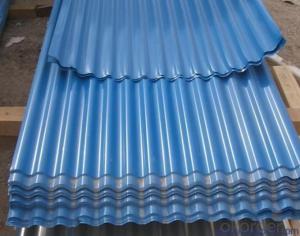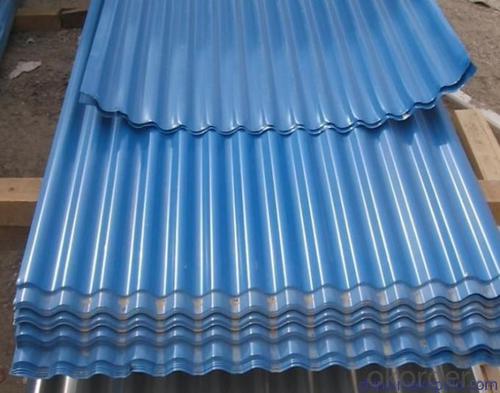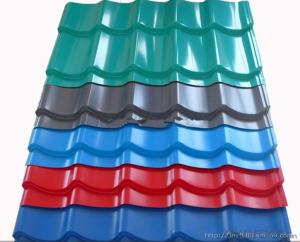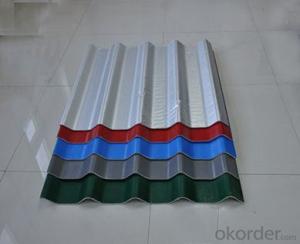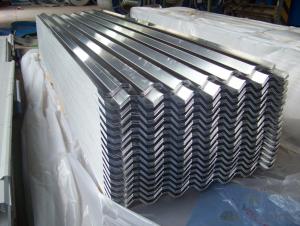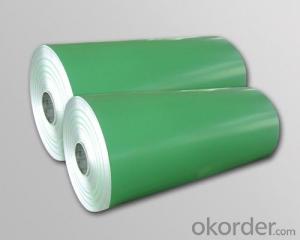Aluminum Sheets Illinois - Coated Aluminum Roof Panels AA1XXX
- Loading Port:
- China Main Port
- Payment Terms:
- TT OR LC
- Min Order Qty:
- -
- Supply Capability:
- -
OKorder Service Pledge
OKorder Financial Service
You Might Also Like
Aluminium Foil Anti-Corrosion Heat Insulation Roofing Sheet is made of stone powder,
and more than 10 different kinds of inorganic chemical materials with the inside backbone fabric glass cloth.
It features high strength, beautiful, durable in use, fireproofing, frost resisting, corrosion resisting etc,
and the product life could reach more than 20 years; it has overwhelming performance advantages
over the other traditional roofing materials, such as asbestos roofing sheet, glass fiber roofing sheet,
cement roofing sheet and steel roofing sheet. The Product has past the test of PuYang City Quality
Supervision and Inspection Center, each performance index has reached and exceed JC / T747-2002
national standard.
| Big Wave | Medium Wave | Small Wave | |
| Length | 1000 mm -7000 mm | 1800, 2400, 3000 mm | 2400 mm |
| Width | 970 mm | 970 mm | 720 mm |
| Tickness | 4.5-6 mm | 4.5-6 mm | 4-6 mm |
| Wave Height | 55 mm | 40 mm | 25 mm |
| Wave Number | 4.5 | 7.5 | 11.5 |
| Wave Distance | 200 mm | 100 mm | 50 mm |
| Weight/ M | 9-11 kg | 9-11 kg | 7-9 kg |
- Q: Are the aluminum sheets suitable for aerospace applications?
- Yes, aluminum sheets are suitable for aerospace applications. Aluminum is widely used in the aerospace industry due to its excellent strength-to-weight ratio, corrosion resistance, and high thermal conductivity. These properties make it an ideal material for manufacturing aircraft structures, such as fuselages, wings, and structural components. Additionally, aluminum can be easily machined and formed into complex shapes, allowing for the production of lightweight and aerodynamic structures. Furthermore, aluminum sheets can be easily joined using various techniques, including welding and riveting, ensuring the structural integrity of aerospace components. Overall, aluminum sheets are well-suited for aerospace applications and have been extensively utilized in the industry for many years.
- Q: Are aluminum sheets suitable for aerospace engine components?
- Aerospace engine components can indeed be made from aluminum sheets. Aluminum is widely employed in the aerospace industry because of its advantageous properties. Its lightweight nature is crucial for aircraft and spacecraft applications, as it aids in reducing overall weight and fuel consumption. Furthermore, aluminum possesses outstanding thermal conductivity, enabling efficient heat dissipation generated by the engine. This characteristic is essential for maintaining optimal operating temperatures. Additionally, aluminum exhibits a commendable strength-to-weight ratio, corrosion resistance, and ease of fabrication. These qualities make it suitable for various engine components like casings, housings, and structural elements. Nevertheless, it is important to note that not all engine components can be solely constructed using aluminum sheets. Certain parts may require higher strength materials or specific alloys to withstand extreme temperatures or stresses. Overall, aluminum sheets have proven to be a reliable and frequently employed material for aerospace engine components. They significantly contribute to the overall performance and efficiency of aerospace engines.
- Q: Explain the distinctions between aluminum sheets and aluminum foil in terms of thickness, uses, and properties.
- <p>Aluminum sheets and aluminum foil are both made from aluminum but differ in thickness and applications. Aluminum sheets are thicker and more rigid, typically used for construction, manufacturing, and as a packaging material. They offer better strength and durability. Aluminum foil, on the other hand, is very thin and flexible, commonly used for food packaging, cooking, and insulation. It's lightweight and has excellent heat and light reflection properties. Aluminum sheets are often anodized or coated for additional properties, while foil is valued for its purity and malleability.</p>
- Q: What are the different methods of surface finishing for aluminum sheets?
- Aluminum sheets can be finished using various methods, each with its own advantages and applications. Some commonly used methods are: 1. Anodizing: By immersing the aluminum sheet in an electrolytic solution and applying an electric current, a protective oxide layer is formed on the surface. Anodizing offers excellent corrosion resistance, durability, and the option to add color or dye for aesthetic purposes. 2. Polishing: This mechanical process involves buffing the aluminum sheet to achieve a smooth and reflective surface. It is commonly used for decorative purposes and to enhance the metal's appearance. 3. Brushing: By using abrasive materials or brushes, a directional grain pattern can be created on the surface of the aluminum sheet. Brushing is often employed in architectural applications or to achieve a distinct textured finish. 4. Powder coating: This method entails applying a dry powder paint to the aluminum sheet's surface, followed by curing it under heat. It provides a durable and vibrant finish, offering excellent resistance to weathering, chemicals, and UV rays. 5. Chemical etching: Acidic or alkaline solutions are used in chemical etching to selectively remove aluminum from the sheet's surface, resulting in a textured or patterned design. It is commonly used for decorative purposes or to improve adhesion for subsequent coatings. 6. Laminating: A protective film or layer is bonded onto the surface of the aluminum sheet in the laminating process. This method offers additional protection against scratches, stains, and physical damage, while also allowing for customization through different film finishes. 7. Sandblasting: High-pressure air or water is used to propel abrasive particles onto the aluminum sheet's surface, creating a textured or matte finish. Sandblasting is often employed to remove impurities, enhance paint adhesion, or achieve a unique appearance. These methods are just a few examples of the many available options for finishing aluminum sheets. The choice of method depends on the desired appearance, functionality, and specific requirements of the application.
- Q: Can aluminum sheets be used for curtain walls?
- Certainly, curtain walls can utilize aluminum sheets. Aluminum proves to be a favored option for curtain wall systems because of its lightweight, enduring, and corrosion-resistant properties. Aluminum sheets can be effortlessly molded into different forms and dimensions, rendering them ideal for crafting the structural framework of curtain walls. Moreover, aluminum can undergo coating or anodization processes to enhance its visual appeal and offer extra safeguard against weather conditions. Consequently, aluminum sheets emerge as a versatile and pragmatic material for erecting curtain walls in both commercial and residential structures.
- Q: what's the size of aluminum sheet circle?
- Aluminum sheet circle’s size is usually the width of coil stock (mm) : 500-1250,800-1400,1000-1600, thickness of coil stock (mm) : 0.4-3.0,1.0-6.0, weight of coil stock (kg) : 8000,10000, diameter of blank(mm) : 85-660,85-750,100-900. Aluminum sheet circle is broadly used in electron, daily chemical industry, medicine, education and car accessories industry. Electrical appliance, thermal insulation, machine manufacturing, cars, spaceflight, military industry, mould, construction, printing and other industries. Kitchenware, such as non-stick pan, pressure cooker, etc. and hardware, such as lampshade, shell of water heater, etc. they are one of the highly processed aluminum products with largest consumption.
- Q: Can aluminum sheets be used for structural purposes?
- Indeed, structural purposes can be fulfilled by utilizing aluminum sheets. This material, known for its lightness and remarkable malleability, can be effortlessly shaped and sized in diverse forms. Thanks to its exceptional strength-to-weight ratio, it is an ideal choice for structural applications that prioritize weight reduction. In industries such as aerospace, automotive, and construction, aluminum sheets are commonly employed to create structural components like panels, beams, and frames. Moreover, the corrosion resistance of aluminum adds to its suitability for structural purposes, particularly in outdoor or marine settings. Ultimately, aluminum sheets present a dependable and economical solution for structural applications.
- Q: Can aluminum sheets be used in construction?
- Yes, aluminum sheets can be used in construction. They are commonly used for roofing, siding, and structural applications due to their lightweight, corrosion-resistant, and durable properties.
- Q: Are aluminum sheets suitable for mold making?
- Indeed, aluminum sheets prove to be a fitting option for mold making. Renowned for its lightweight nature, durability, and remarkable heat conductivity, aluminum emerges as a favored material for mold creation. These remarkable attributes render it suitable for molding processes, whether they involve low temperatures or high temperatures. Furthermore, aluminum lends itself well to machining and can be effortlessly shaped into intricate forms, enabling the production of elaborate molds. Its resistance to corrosion further guarantees the molds' durability. In essence, owing to their adaptability and dependability, aluminum sheets enjoy extensive employment in the realm of mold making.
- Q: Can aluminum sheet be bent or formed into different shapes?
- Yes, aluminum sheet can be bent or formed into different shapes through processes such as bending, rolling, or pressing, due to its malleability and ductility.
Send your message to us
Aluminum Sheets Illinois - Coated Aluminum Roof Panels AA1XXX
- Loading Port:
- China Main Port
- Payment Terms:
- TT OR LC
- Min Order Qty:
- -
- Supply Capability:
- -
OKorder Service Pledge
OKorder Financial Service
Similar products
Hot products
Hot Searches
Related keywords
